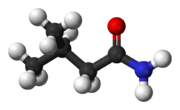Chemistry:Isovaleramide
From HandWiki

| |

| |
| Names | |
|---|---|
| Preferred IUPAC name
3-Methylbutanamide | |
| Other names
Isopentanamide
Isovaleric acid amide Isovaleric amide beta-Methylbutyramide | |
| Identifiers | |
3D model (JSmol)
|
|
| ChemSpider | |
| EC Number |
|
| KEGG | |
PubChem CID
|
|
| UNII | |
| |
| |
| Properties | |
| C5H11NO | |
| Molar mass | 101.149 g·mol−1 |
| Appearance | colourless solid |
| Melting point | 137 °C (279 °F; 410 K) |
| Boiling point | 226 °C (439 °F; 499 K) |
Except where otherwise noted, data are given for materials in their standard state (at 25 °C [77 °F], 100 kPa). | |
| Infobox references | |
Tracking categories (test):
Isovaleramide is an organic compound with the formula (CH3)2CHCH2C(O)NH2. The amide derived from isovaleric acid, it is a colourless solid.
Occurrence and biological activity
Isovaleramide is a constituent of valerian root.
In humans, it acts as a mild anxiolytic at lower doses and as a mild sedative at higher dosages.[1] Isovaleramide has been shown to be non-cytotoxic and does not act as a CNS stimulant. It inhibits the liver alcohol dehydrogenases and has a reported -1">50 of greater than 400 mg/kg when administered intraperitoneally in mice.[2]
It is a positive allosteric modulator of the GABAA receptor, similarly to isovaleric acid. [3]
References
- ↑ Balandrin, Manuel F. & Bradford C. Van Wagenen, "Use of isovaleramide as a mild anxiolytic and sedative agent", US patent 5506268, published 1996-04-09, assigned to NPS Pharmaceuticals Inc.
- ↑ Taillandier, Georges; Benoit-Guyod, Jean L.; Boucherle, Andre; Broll, Madeleine; Eymard, Pierre (1975). "Dipropylacetic series. XII. Anticonvulsant branched aliphatic acids and alcohols". European Journal of Medicinal Chemistry 10 (5): 453–462.
- ↑ "[Isovaleramide, an anticonvulsant molecule isolated from Valeriana pavonii]" (in es). Biomedica 30 (2): 245–50. 2010. doi:10.7705/biomedica.v30i2.187. PMID 20890571.
 |
